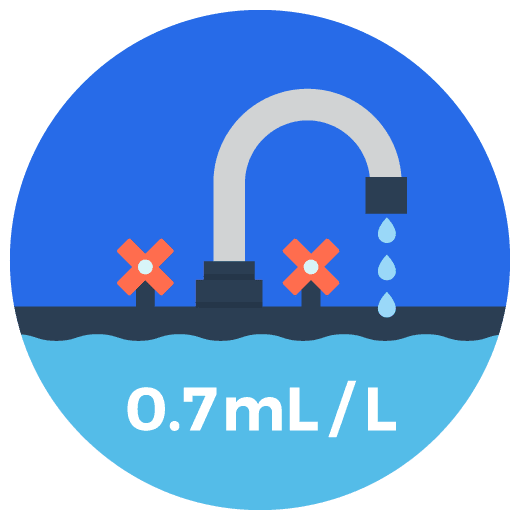What is fluoride?
Basics of fluoride and water fluoridationWhen we have access to the right balance of fluoride, it strengthens our tooth enamel and reduces decay.
Fluoride is a mineral found in Washington’s rivers, lakes and the Puget Sound. Throughout the US, public water systems adjust the fluoride to an optimal level through a process known as “fluoridation.” As people drink fluoridated water throughout the day and brush after breakfast and before bed with fluoride toothpaste, our teeth are bathed in the mineral. A vast majority of health experts in the United States have advocated for the combination of drinking water with fluoride and brushing twice daily as an essential way to prevent tooth decay in children, adults and seniors.
See the fluoride mechanism at work.

What is fluoride?
Fluoride is nature’s cavity fighter, found in virtually all water supplies, including fresh and saltwater sources in our state. Fluoride is a component of fluorine, one of the top 20 most common elements on the surface of the Earth.
While fluoride occurs naturally in water, some sources only contain trace amounts of the mineral, not enough to protect our teeth. Through community water fluoridation, the amount of fluoride in water is balanced to strengthen teeth and prevent tooth decay.
What is fluoride?
Fluoride is nature’s cavity fighter, found in virtually all water supplies, including fresh and saltwater sources in our state. Fluoride is a component of fluorine, one of the top 20 most common elements on the surface of the Earth.
While fluoride occurs naturally in water, some sources only contain trace amounts of the mineral, not enough to protect our teeth. Through community water fluoridation, the amount of fluoride in water is balanced to strengthen teeth and prevent tooth decay.

Fluoride is found in Washington rivers, lakes, and the Puget Sound.
Why is fluoride important?
Bacteria in our mouths convert the sugars from foods and beverages into acid that is harmful to our teeth. The fluoride in our drinking water mixes with our saliva to protect our teeth from this acid. Decades of research have demonstrated that water fluoridation adds crucial protection against tooth decay.
Fluoridation leads to healthy mouths, which has a positive effect on people of all ages. Children with healthy mouths do better in school and are more likely to thrive when they grow up. Adults have less of a chance of losing their teeth and needing dentures and costly implants. Overall, better oral health saves families and taxpayers money by reducing the need for unnecessary dental treatments.

History of water fluoridation
Dentists discover what fluoride is: Nature’s cavity fighter
1901:
Dr. McKay’s Discovery
In the early 20th century, Dr. Frederick McKay began work as a dentist in Colorado Springs, where he found children with teeth that were highly resistant to cavities. With the help of a chemist, he eventually found that these children were drinking mountain water rich with fluoride. However, the high level of fluoride left a harmless brown stain on teeth.
1930s:
Dr. Dean’s Landmark Research
Dr. H. Trendley Dean was head of the Dental Hygiene Unit at the National Institute of Health. Building on Dr. McKay’s discovery, Dr. Dean and his research team found that fluoride levels of up to 1.0 parts per million did not cause the brown stains on the enamel and could be used to improve oral health.
1945:
Michigan Leads the Way
In 1945, Grand Rapids, Michigan, became the first city in the world to begin water fluoridation. Over the next 15 years, researchers looked at the rate of tooth decay among the city’s 30,000 school children and found that it dropped by more than 60%. Scientists concluded for the first time that tooth decay is preventable.
1950s–1960s:
Boom for Fluoridation
Over the next two decades, thousands of communities across the United States began providing a balance of fluoride in their drinking water, and by doing so, they were able to reduce their rates of tooth decay significantly. Fluoride toothpaste and office treatments were added in as key additional methods for getting the right balance of fluoride. The Centers for Disease Control and Prevention (CDC) now says that water fluoridation reduces tooth decay up to 25% over a lifetime on top of the cavity prevention benefits of fluoride toothpaste.
1999:
A Public Health Achievement
The CDC recognizes water fluoridation as one of the “ten great public health achievements” of the twentieth century. Other successes in the top ten include vaccination, control of infectious diseases, and recognition of tobacco use as a health hazard.
2000+:
21st Century and Beyond
Fluoride and fluoridation were among the most researched topics of the second half of the 20th century, and studies in the 21st century continue to reaffirm water fluoridation’s health benefits. Among the findings: fluoridation helps close the gap in tooth decay rates among various groups and saves money by lowering the need for tooth fillings and other dental procedures.
History of water fluoridation
Dentists discover what fluoride is: Nature’s cavity fighter
1901:
Dr. McKay’s Discovery
In the early 20th century, Dr. Frederick McKay began work as a dentist in Colorado Springs, where he found children with teeth that were highly resistant to cavities. With the help of a chemist, he eventually found that these children were drinking mountain water rich with fluoride. However, the high level of fluoride left a harmless brown stain on teeth.
1930s:
Dr. Dean’s Landmark Research
Dr. H. Trendley Dean was head of the Dental Hygiene Unit at the National Institute of Health. Building on Dr. McKay’s discovery, Dr. Dean and his research team found that fluoride levels of up to 1.0 parts per million did not cause the brown stains on the enamel and could be used to improve oral health.
1945:
Michigan Leads the Way
In 1945, Grand Rapids, Michigan, became the first city in the world to begin water fluoridation. Over the next 15 years, researchers looked at the rate of tooth decay among the city’s 30,000 school children and found that it dropped by more than 60%. Scientists concluded for the first time that tooth decay is preventable.
1950s–1960s:
Boom for Fluoridation
Over the next two decades, thousands of communities across the United States began providing a balance of fluoride in their drinking water, and by doing so they were able to reduce their rates of tooth decay significantly. Fluoride toothpaste and office treatments were added in as key additional methods for getting the right balance of fluoride. The Centers for Disease Control and Prevention (CDC) now says that water flouridation reduces tooth decay up to 25% over a lifetime on top of the cavity prevention benefits of fluoride toothpaste.
1999:
A Public Health Achievement
The CDC recognizes water fluoridation as one of the “ten great public health achievements” of the twentieth century. Other successes in the top ten include vaccination, control of infectious diseases, and recognition of tobacco use as a health hazard.
2000+:
21st Century and Beyond
Fluoride and fluoridation were among the most researched topics of the second half of the 20th century and studies in the 21st century continue to reaffirm water fluoridation’s health benefits. Among the findings: fluoridation helps close the gap in tooth decay rates among various groups and saves money by lowering the need for tooth fillings and other dental procedures.

How is water fluoridated?
Water operators balance the level of fluoride in water. Fluoridation does not affect the appearance, taste or smell of drinking water.

What is an effective level of fluoride?
The U.S. Public Health Service recommends an effective level of fluoride concentration in water, which is 0.7 milligrams per liter. Local water operators closely monitor and adjust these levels to benefit public health.



How much does it cost to regulate?
The cost of fluoridating a local water system is cost effective over the short and long term. It can range from 11 cents to $24.38 per person per year.


How is water fluoridated?
Water operators balance the level of fluoride in water. Fluoridation does not affect the appearance, taste or smell of drinking water.



What is an effective level of fluoride?
The U.S. Public Health Service recommends an effective level of fluoride concentration in water, which is 0.7 milligrams per liter. Local water operators closely monitor and adjust these levels to benefit public health.



How much does it cost to regulate?
The cost of fluoridating a local water system is cost effective over the short and long term. It can range from 11 cents to $24.38 per person per year.


Who supports water fluoridation?
Health experts, local governments and community organizations support fluoridation as a way of giving all Washingtonians equal access to good health.
